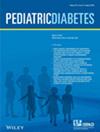青年1型糖尿病患者未确诊乳糜泻的频率及其与糖尿病视网膜病变的关系:青年糖尿病研究
IF 3.9
3区 医学
Q2 ENDOCRINOLOGY & METABOLISM
引用次数: 0
摘要
目标成人1型糖尿病患者的乳糜泻(CD)与心血管风险增加和糖尿病相关并发症的早期发生有关。在青年糖尿病研究中,我们旨在评估儿童期发病的1型糖尿病青年中乳糜泻的频率和未确诊乳糜泻的可能性。此外,我们通过CD状态和IgA组织转谷氨酰胺酶自身抗体(tTGA)水平评估了青年1型糖尿病患者心血管危险因素和糖尿病相关并发症的负担。方法:2444名青少年1型糖尿病患者完成了一份CD问卷,并进行了tTGA测试。结合乳糜泻问卷和tTGA结果进行横断面分析,参与者分为以下几类:(1)报告的乳糜泻;(2)乳糜泻血清阳性(未见乳糜泻报告,tTGA血清阳性);(3)仅为1型糖尿病(对照组:未报告CD和血清tTGA阴性)。对未报告的CD和tTGA≥10倍ULN的患者进行亚分析,指定潜在未诊断的CD。通过CD状态和tTGA水平评估心血管危险因素和糖尿病相关并发症,利用泊松模型估计相对风险。结果。据报道,青少年1型糖尿病患者的乳糜泻发生率为7%。未报告CD的tTGA血清阳性为4%,潜在未诊断CD的为1.2%。潜在未诊断CD的青少年患糖尿病视网膜病变的风险比对照组高2.69倍。此外,tTGA≤0.05(控制CD)的CD与较低的HbA1c相关。结论。未确诊的乳糜泻很可能存在于1型糖尿病青少年中,潜在的未确诊的乳糜泻与糖尿病视网膜病变的高风险相关。这些发现表明,在青少年1型糖尿病患者中,常规筛查乳糜泻的重要性。本文章由计算机程序翻译,如有差异,请以英文原文为准。
The Frequency of Undiagnosed Celiac Disease in Youth with Type 1 Diabetes and Its Association with Diabetic Retinopathy: The SEARCH for Diabetes in Youth Study
Aims. Celiac disease (CD) in adults with type 1 diabetes has been associated with increased cardiovascular risk and the earlier occurrence of diabetes-associated complications. In the Search for Diabetes in Youth study, we aimed to assess the frequency of CD and the potential for undiagnosed CD among youth with childhood onset type 1 diabetes. In addition, we assessed the burden of cardiovascular risk factors and diabetes-associated complications in youth with type 1 diabetes by CD status and IgA tissue transglutaminase autoantibody (tTGA) levels. Methods. 2,444 youths with type 1 diabetes completed a CD questionnaire and underwent tTGA testing. Integrating the celiac disease questionnaire and tTGA results for this cross-sectional analysis, participants were categorized as follows: (1) reported CD; (2) seropositive for CD (no reported CD and seropositive tTGA); and (3) type 1 diabetes only (comparison group: no reported CD and seronegative tTGA). Subanalyses were performed on those with no reported CD and tTGA ≥10x ULN, designated potentially undiagnosed CD. Cardiovascular risk factors and diabetes-associated complications were evaluated by CD status and tTGA levels utilizing a Poisson model to estimate relative risk. Results. Reported CD in youths with type 1 diabetes was 7%. Seropositivity for tTGA with no reported CD was present in 4%, and 1.2% had potentially undiagnosed CD. Youths with potentially undiagnosed CD had a 2.69x higher risk of diabetic retinopathy than comparison group. In addition, CD with tTGA <0.05 (controlled CD) was associated with lower HbA1c. Conclusions. Undiagnosed CD is likely present in youths with type 1 diabetes and potentially undiagnosed CD is associated with a higher risk of diabetic retinopathy. These findings indicate the importance of routine screening for CD in type 1 diabetes in youths.
求助全文
通过发布文献求助,成功后即可免费获取论文全文。
去求助
来源期刊

Pediatric Diabetes
医学-内分泌学与代谢
CiteScore
6.60
自引率
14.70%
发文量
141
审稿时长
4-8 weeks
期刊介绍:
Pediatric Diabetes is a bi-monthly journal devoted to disseminating new knowledge relating to the epidemiology, etiology, pathogenesis, management, complications and prevention of diabetes in childhood and adolescence. The aim of the journal is to become the leading vehicle for international dissemination of research and practice relating to diabetes in youth. Papers are considered for publication based on the rigor of scientific approach, novelty, and importance for understanding mechanisms involved in the epidemiology and etiology of this disease, especially its molecular, biochemical and physiological aspects. Work relating to the clinical presentation, course, management and outcome of diabetes, including its physical and emotional sequelae, is considered. In vitro studies using animal or human tissues, whole animal and clinical studies in humans are also considered. The journal reviews full-length papers, preliminary communications with important new information, clinical reports, and reviews of major topics. Invited editorials, commentaries, and perspectives are a regular feature. The editors, based in the USA, Europe, and Australasia, maintain regular communications to assure rapid turnaround time of submitted manuscripts.
 求助内容:
求助内容: 应助结果提醒方式:
应助结果提醒方式:


